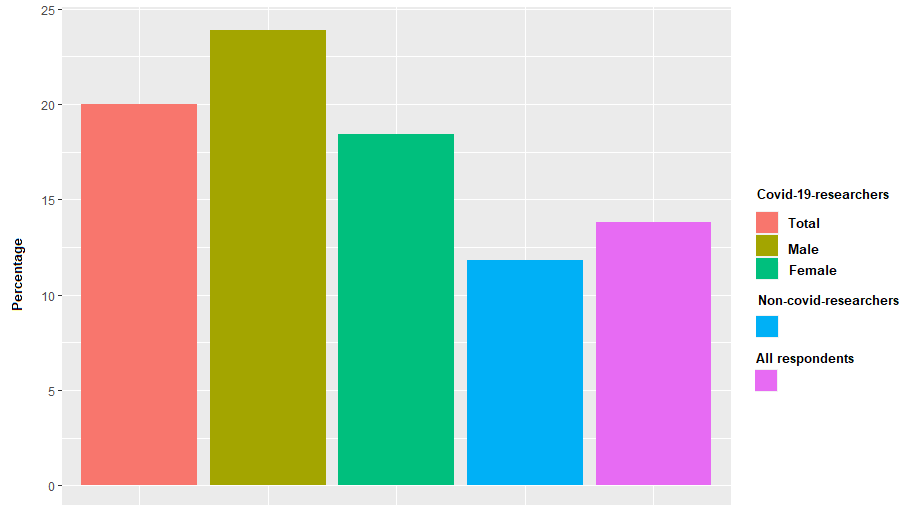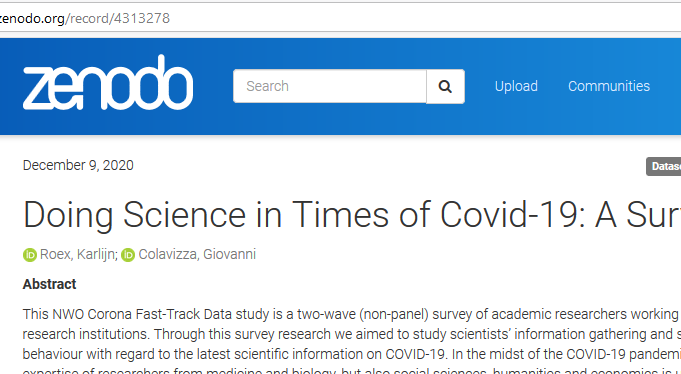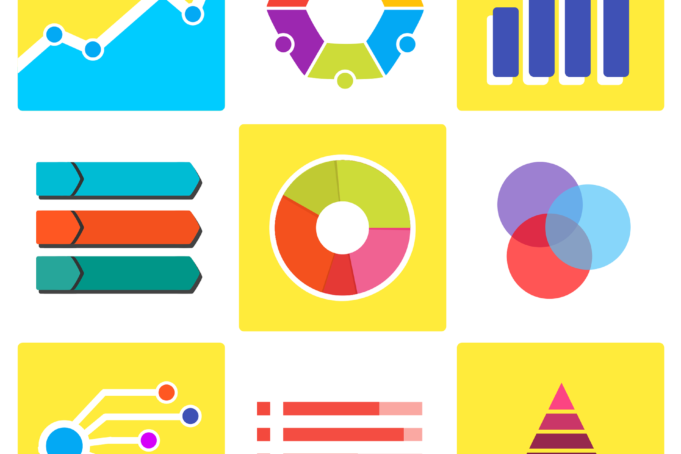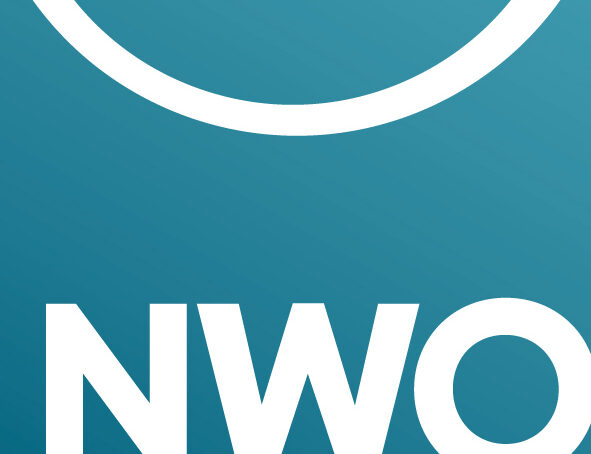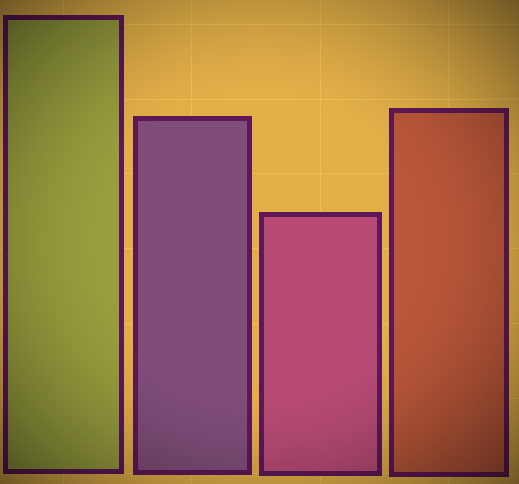
The COVID-19 pandemic has transformed the channels and methods through which scientific findings are communicated. Instead of waiting to publish a full journal article, scientists already reveal ‘tidbits of scientific data’ through preprints, which contributed to fast sharing of early and crucial insights (Koerber, 2020). More than ever, experts find themselves in a role in which they have to correct rapidly circulating misinformation. In this global health crisis, reliance on scientific experts is of vital importance. In June-August, we – Giovanni Colavizza and Karlijn Roex – conducted a survey study among academic researchers. We are currently conducting a second round of the survey. All academic researchers based in The Netherlands can participate through this link.
Gender inequalities in speaking up against COVID-19 misinformation
We asked respondents whether they had responded to COVID-19-related misinformation in the last four weeks (N = 498). On average, almost a quarter had done so (24.2%) on online fora. Scholars that study COVID-19-related issues, were slightly more active in this (26.0%) than ‘non-COVID-researchers’ (17.2%). Male COVID-19-researchers (N = 46) were more likely to have done so (30.4%) than their female colleagues (N = 75, of which 23.7% did so). Figure 7 displays the percentages.
Figure 1. Researchers who responded to misinformation on online fora.
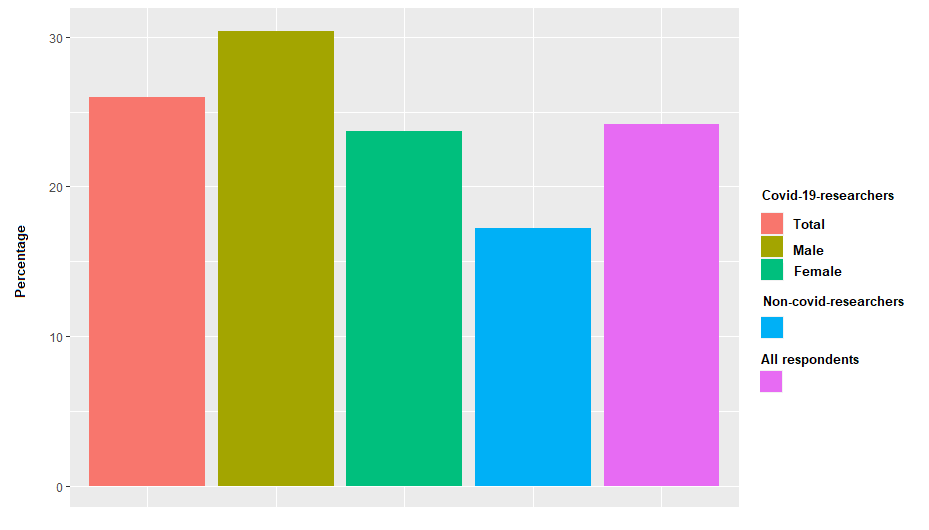
We also asked respondents whether they had responded to COVID-19-related misinformation by commenting in some international or national news outlets (N = 500). The hurdle to do so (such as selective editors, or being granted the opportunity by being interviewed) is higher than for commenting on online fora. Yet, a remarkable 13.8% of the sample had done so – in the last four weeks before participating in the survey. Again, those working on COVID-19-related issues were most likely to do so (20%), compared to 11.8% of non-COVID-researchers. Because the hurdle of speaking out in the media is higher, it is potentially less difficult to do so for those considered experts – which are in this case those working on COVID-19-related research. And again, females working in COVID-19-related research (N = 76) were less likely to have commented in the media (18.4%) than their male counterparts (23.9% of a total N of 46).
This clearly resonates with a result of a recent research report titled ‘The Missing Perspectives of Women in COVID-19 News’ (Kassova, 2020). At the same time, our sample of COVID-19 researchers consists of more females than males – which appears to be different from other studies based on researchers’ published work. This could suggest the presence of an undervalued female labour behind the COVID-19 breakthroughs highlighted in publications and citations – and could be an interesting direction for further research.
Figure 2. Researchers who responded to misinformation in the press.
Researchers desire greater press influence of COVID-19 experts
What do we think about the influence of scientific experts on COVID-19 in major news outlets? How big is this influence perceived by academic researchers? Our respondents (N = 478) were quite optimistic. Asked to rate the perceived influence between 0 and 100, they gave an average estimation of 64.3. Indeed, COVID-19-researchers were more optimistic (68.1) than their other colleagues in academia (63.2). Disagreement was virtually identical within each group (SD = 19 and 21 respectively).
Although this rating indicates some optimism, our respondents still preferred to see an increase in press influence for COVID-19 experts. The average preferred degree of influence was 72.3. Here, the differences between those who are working on COVID-19-related research and those who do not, are smaller (73.6 versus 71.7).
Open science is widely endorsed, and most so in COVID-19-related research
One of the notorious changes that the SARS-CoV-2 pandemic evoked, was an acceleration of a longer-term progression towards more open access and open source academic work. Scholarly journals have released more of their articles open access, in order to enable a faster and wider exchange of knowledge on an urgent topic. A Frontiers survey study conducted in June reveals that this pandemic has motivated international researchers to consider publishing open access. As much as 44% of academic researchers said to be more likely to publish in an open access journal as result of the pandemic, and 45% considered sharing their data in the future. Researchers share their data, code, instrument and models to others in order to better help the community in finding innovative solutions for pressing problems.
An inspiring recent Dutch anecdote is the revamped BCG tuberculosis vaccine research, kicked off as a fast track project by the Radboud MC and Utrecht UMC immediately after the pandemic had started (see interview with Bonten, 2020). Researchers abroad have picked up the idea, eventually leading to as much as 15 local studies to the potential of this vaccine. The data will be immediately shared across these research groups, without the usual competitive hesitation. This way, stronger analyses can be conducted. Another Dutch example is the work of Dutch PhD candidate Marino van Zelst and his colleague in data science Edwin Veldhuizen. They process, analyze and display official Dutch COVID-19 data in a way that is remarkably intelligible and transparent for the wide audience. They post all data files and code online.
With this, it is perhaps unsurprising to find that almost 400 of our 646 respondents indicated to have recently encountered scientific information related to COVID-19. And that these people, on average, estimated that as much as 62.8% of the encountered work was open access or open source. This high estimation was given regardless of whether people themselves were active in COVID-related research (65.2% for those that did versus 62.0 for the rest). Only 7 people indicated they had never encountered any work that was open access or open source in the last four weeks. Indeed, almost three quarter of the respondents (71.5%) had estimated that at least half of the encountered COVID-19 work was open access or open source.
What are our respondents’ own behaviours and attitudes regarding open science? We asked respondents to think back of the work related to COVID-19 that they shared in the last four weeks – if they did so. This was the case for 73 respondents. We asked these people to estimate what percentage (0-100) of this work was free for anybody to read (open access) and/or to develop (open source). On average, people judged this to be the case for as much as 73.1% of the work they shared on COVID-19. Respondents did not substantially differ in their open science sharing behaviour along gender lines, age or their academic fields (e.g. Social Sciences, Health Studies/ Medical Sciences).
Regardless of their own research topics, respondents on average estimated that 73% of the work they recently had shared on COVID-19 was open access or open source.
The only notable differences were between COVID-researchers and non-COVID-researchers. The first had a higher tendency to use open access or open source (78.1%) material compared to non-COVID-researchers (still as high as 66.5%). This difference may be explained by the simple practical fact that academics are more likely to share scientific work about their own research topic.
Still, differential attitudes may also play a role. We asked our respondents (N = 510) a hypothetical question: “If you were to choose between different ways to keep up to date or share the latest COVID-19 research, how important is it for you that a channel provides free access for all to read (open access) or develop (open source) the articles, datasets or applications?” The advantage of this hypothetical survey item is that it gives us information about respondents’ attitudes towards open science in the context of COVID-19, without immediately depending on the extent to which people are actually sharing gathering or sharing information on COVID-19.
Overall, we find that a majority considers ‘open science’ as a desirable phenomenon. Almost half of the sample (47.7%) stated that it is ‘very important’ to them that a channel provides open access or open source content. An additional 174 respondents (34.1%) rank this as ‘important’, and only 9 (1.8%) dismiss this as ‘unimportant’. The urgency is even more emphasized by scholars working on COVID-19-related questions (N = 126). As much as 84.1% of those researchers think it is ‘(very) important’. Only 1 COVID-researcher replied that it was ‘unimportant’. Of all ‘non-COVID-researchers’ that replied (N = 382), as much as 78.5% think that this is ‘(very) important’. Only 8 (2.1%) thought it was unimportant.
Next steps
We will move into deeper analyses. For instance: we want to discover trend patterns in the data and test our hypotheses. Does the heightened epistemological and social uncertainty of the pandemic change the way in which we seek and share information? In order to make valid inferences about the wider research population in the Netherlands, we are developing survey weights in order to account for different sampling probabilities. This was not done yet for the present descriptive analyses – so caution in making broader inferences is warranted. You can stay up to date about this by visiting our website or contacting the researcher Karlijn Roex: k.l.a.roex@uva.nl. We hope that our unique data and deeper analyses will help different parties with improving science communication, open science practices and misinformation interventions.

